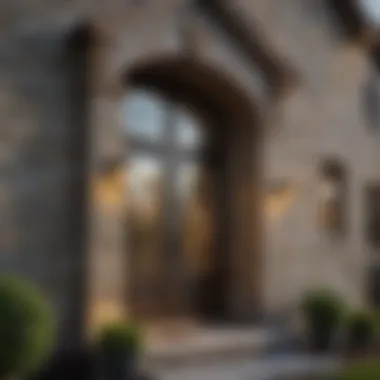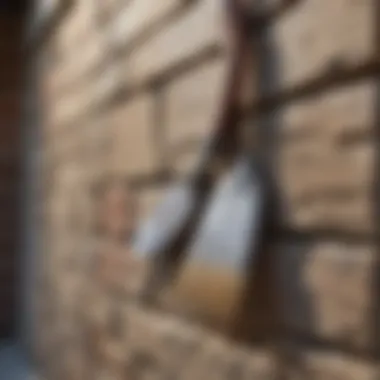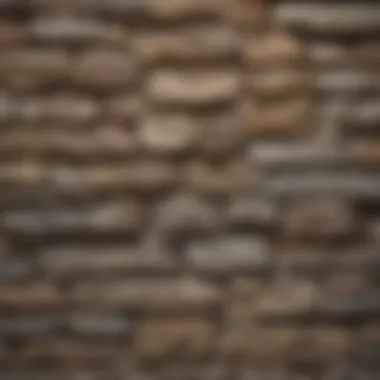A Comprehensive Guide to Replacing Vinyl Siding with Faux Stone: Transform Your Home's Exterior


Materials:
To embark on the transformation from vinyl siding to faux stone, several materials are imperative. You will require measuring tape to accurately calculate dimensions, ensuring precise cuts. Next, procure faux stone panels of the desired color and size. Alongside this, cement board is vital for creating a sturdy base for the faux stone installation. Additionally, galvanized nails offer robust fixation, guaranteeing longevity. Silicone caulk is essential for sealing gaps and securing edges, preventing moisture intrusion.
DIY Steps:
Commencing this project necessitates meticulous planning and execution. Begin by measuring the dimensions of each wall to determine the required faux stone panels and cement boards. Next, mark the studs on the wall to identify the ideal points for nail insertion. Subsequently, cut the cement board to fit the wall dimensions accurately, ensuring a snug fit for the faux stone panels. Fasten the cement board to the studs using galvanized nails, establishing a secure foundation for the faux stone installation.
Technical Aspects:
Executing this project effectively demands specific tools and techniques. Utilize a circular saw for precise cutting of the cement board, ensuring seamless edges for a professional finish. An electric drill with galvanized screws is indispensable for affixing the cement board securely to the wall. Employ a caulking gun to apply silicone caulk along the seams, enhancing weather resistance. To expedite the process, consider using a nail gun for efficient attachment of both the cement board and faux stone panels.
DIY Project Process:


The sequential nature of this project ensures a systematic approach to the installation process. Begin by attaching the first row of faux stone panels at the bottom of the wall, starting from one end and working towards the other. Secure each panel in place by nailing it to the cement board, ensuring a snug and flush fit. Continue this pattern row by row, interlocking the panels for a seamless appearance. Lastly, apply silicone caulk along the edges and seams to fortify the installation against external elements.
Troubleshooting Tips:


In the event of challenges during the installation process, consider these troubleshooting tips. If gaps appear between faux stone panels, utilize additional silicone caulk to fill and seal them effectively. Should panels not align correctly, adjust their positioning by gently tapping them into place with a rubber mallet. For any visible nail heads, use a color-matching touch-up paint to conceal them seamlessly. By adhering to these troubleshooting tips, you can overcome common obstacles and attain a flawless faux stone installation.
Preamble


Replacing vinyl siding with faux stone can significantly enhance the exterior appearance of your home while providing long-lasting benefits. This detailed guide delves into the process of transitioning from vinyl siding to faux stone, offering insights and considerations for a successful renovation project.
Understanding the Appeal of Faux Stone
Natural Aesthetic
Faux stone's natural aesthetic replicates the charm of real stone, adding a touch of sophistication to any exterior. The meticulous craftsmanship in mimicking the textures and colors of natural stone contributes to a visually appealing facade. While offering a visual delight, the natural aesthetic of faux stone also ensures a versatile and durable option for homeowners seeking an upscale finish.
Durable and Long-lasting
The durability of faux stone makes it a prime choice for those looking for sustainable and long-lasting exterior solutions. Its ability to withstand harsh weather conditions, resist fading, and maintain structural integrity over time sets it apart from conventional siding materials. Incorporating faux stone can elevate not just the appearance but also the resilience of your home's exterior.
Variety of Designs
Faux stone provides homeowners with a myriad of design options to suit their preferences and architectural style. From classic elegance to modern chic, the variety of designs available ensures a seamless blend with any home aesthetics. This versatility allows homeowners to personalize their exteriors while reaping the benefits of durability and low maintenance.
Why Replace Vinyl Siding?
Enhanced Curb Appeal
Enhancing the curb appeal of your home with faux stone can elevate its overall aesthetic appeal. The textured surface and authentic look of faux stone create a visual interest that surpasses traditional vinyl siding. By opting for faux stone, you can transform your home's exterior into a focal point in the neighborhood, garnering admiration and envy.
Improved Insulation
Upgrading to faux stone provides improved insulation properties, helping regulate indoor temperature and reduce energy costs. The insulating characteristics of faux stone ensure better thermal performance, keeping your home comfortable in all seasons. This energy-efficient feature not only enhances living conditions but also contributes to a sustainable lifestyle.
Long-term Cost Savings
Investing in faux stone as a replacement for vinyl siding yields long-term cost savings through its durability and minimal upkeep requirements. While the initial investment may seem higher, the reduced maintenance and longevity of faux stone result in significant financial benefits over the years. By choosing faux stone, homeowners can enjoy a beautiful exterior without worrying about frequent repairs or replacements.
Choosing the Right Faux Stone Material
Faux stone material selection is a pivotal decision in the transition from vinyl siding to a more sophisticated exterior look. Homeowners embarking on this journey must carefully weigh their options to achieve the desired aesthetic and structural enhancement. By assessing the facets of natural versus synthetic faux stone, individuals can determine the ideal fit for their residence. One key consideration lies in the balance between authenticity and affordability. Balancing these two elements ensures a realistic appearance without exceeding the budget. The authenticity of natural faux stone exudes charm and elegance, mimicking genuine stone's texture and color variations, enhancing the home's visual appeal. Conversely, synthetic faux stone offers a cost-effective alternative that still delivers a visually pleasing facade, catering to those with budget constraints. Selecting the right faux stone material is crucial, as it sets the foundation for the entire transformation process, impacting the overall outcome significantly.
Natural vs. Synthetic Faux Stone
Authenticity vs. Affordability
Color and Texture Selection
Harmonizing with Exterior
Personal Style Preference
Preparing for Installation
When it comes to embarking on the journey of replacing vinyl siding with faux stone, a critical phase involves preparing for the installation. This preparatory stage sets the foundation for a successful transformation of your home's exterior. Assessing the conditions of the existing siding and gathering the necessary tools and materials are paramount to ensure a smooth installation process.
Assessing the Condition of Existing Siding
Before diving into the installation of faux stone panels, it is imperative to evaluate the current state of your home's siding. This evaluation serves as a guideline to determine whether repairs are needed or if complete removal is more suitable. The decision between repair or removal depends on factors such as the extent of damage, age of the siding, and overall aesthetic goals.
Repair or Removal
One key aspect of assessing the condition of existing siding is deciding between repair or removal. Repairing the siding involves fixing damaged sections, addressing wear and tear, and ensuring the surface is suitable for the new faux stone panels. On the other hand, opting for removal entails taking down the old vinyl siding entirely to make way for the installation of faux stone. The choice between repair and removal hinges on the long-term durability and visual appeal you aim to achieve with the faux stone upgrade.
Structural Integrity Check
Conducting a structural integrity check is a crucial step in the assessment process. This involves evaluating the underlying structure beneath the siding to ensure it can support the weight and installation of faux stone panels. Issues such as rot, moisture damage, or structural deficiencies must be addressed before proceeding with the installation. A thorough structural inspection guarantees the stability and longevity of the faux stone cladding.
Gathering Necessary Tools and Materials
Equipping yourself with the essential tools and materials is vital for a successful faux stone installation. From specialized equipment to quality adhesives, each component plays a significant role in the overall outcome of your home's exterior upgrade.
Essential Equipment
The essential equipment needed for the installation includes cutting tools, measuring devices, leveling instruments, safety gear, and accessories for handling the faux stone panels. These tools facilitate precise and seamless placement of the panels, ensuring a professional finish that enhances the aesthetic appeal of your home.
Quality Adhesives
Selecting the right adhesives is critical to the durability and stability of the faux stone cladding. High-quality adhesives not only ensure a secure bond between the panels and the siding but also contribute to the weather resistance and longevity of the installation. Choosing reliable adhesives tailored for exterior applications is essential for a robust and visually pleasing faux stone transformation.
Installation Process
When delving into the realm of replacing vinyl siding with faux stone, the installation process stands as the pivotal juncture where transformation takes shape. This section encapsulates the essence of seamlessly transitioning from outdated siding to a new, sophisticated facade. The meticulous execution of the installation process ensures a durable and visually appealing outcome that elevates the curb appeal of your abode.
Surface Preparation
Cleaning and Priming
Embarking on the journey of rejuvenating your home's exterior through faux stone entails a crucial step of cleaning and priming the underlying surface. This preliminary phase sets the foundation for impeccable adhesion, ensuring the faux stone panels adhere steadfastly for years to come. Through a meticulous cleansing process, any dirt, grime, or remnants of the previous siding are eradicated, guaranteeing a pristine canvas for the faux stone application.
The primary characteristic that distinguishes the cleaning and priming stage is its efficacy in enhancing the longevity of the faux stone installation. By ridding the surface of any impurities, the adhesion of the faux stone panels is optimized, minimizing the risk of displacement or detachment over time. This meticulous preparation not only contributes to the durability of the faux stone but also enhances its aesthetic appeal, showcasing a flawless finish that exudes elegance.
Ensuring Proper Adhesion
As the adhesive element binding the faux stone panels to your home's exterior, ensuring proper adhesion is paramount in achieving a seamless and enduring transformation. The key characteristic of this meticulous process lies in its ability to fortify the attachment of the faux stone panels, safeguarding against external elements and structural strain.
The unique feature of ensuring proper adhesion rests in its comprehensive approach towards securing the faux stone panels, mitigating the risk of detachment or displacement. By meticulously adhering to the recommended techniques and quality adhesives, the installation process guarantees a reliable and long-lasting outcome. While the meticulous attention to detail in this phase elevates the overall installation quality, it also fortifies the structural integrity of your home's exterior, ensuring a resilient facade that withstands the test of time.
Applying Faux Stone Panels
Cutting and Sizing
Precision and accuracy define the pivotal phase of cutting and sizing faux stone panels, where attention to detail plays a critical role in achieving a seamless application. This specific aspect underscores the importance of customizing the panels to fit the unique dimensions of your home's exterior, ensuring a tailored and flawless finish that resonates with your design vision.
The key characteristic of cutting and sizing lies in its adaptability to various architectural nuances, allowing for a tailored application that harmonizes with the distinctive features of your abode. This meticulous customization not only enhances the visual cohesion of the faux stone panels but also ensures a structurally sound installation, free from gaps or inconsistencies.
Securing in Place
Securing the meticulously cut and sized faux stone panels in place is the culmination of the installation process, where meticulous attention to detail ensures a flawless finish. The key characteristic of this phase is its focus on stability and durability, guaranteeing that the panels are securely fastened to withstand varying weather conditions and external factors.
The unique feature of securing in place lies in its ability to create a robust and long-lasting bond between the faux stone panels and your home's exterior. By adopting best practices in securing the panels, such as utilizing quality fasteners and adhesives, the installation process culminates in a visually striking facade that remains steadfast over time. This meticulous approach not only enhances the aesthetic appeal of your home but also reinforces its structural integrity, offering a durable exterior that enhances both form and function.
Finishing Touches and Maintenance
After successfully replacing vinyl siding with faux stone, paying attention to finishing touches and maintenance is crucial to uphold the new exterior's appeal and longevity. In this final stage of the transformation process, focus shifts to preserving the installation's quality and safeguarding against potential issues. Sealing and Caulking play a pivotal role in this stage, offering protection against moisture penetration and enhancing the overall durability of the faux stone exterior.
Sealing and Caulking
Protecting Against Moisture
Protecting against moisture is paramount to avert any water-related damage that could compromise the faux stone siding. The application of high-quality sealants and caulks creates a barrier, preventing moisture from seeping into the underlying structure. By adequately sealing gaps and joints, the exterior remains impervious to water infiltration, safeguarding against rot, mold, and structural degradation. This moisture barrier not only preserves the aesthetic appeal of the faux stone but also ensures the longevity of the entire home exterior.
Enhancing Longevity
Enhancing the longevity of the faux stone siding involves more than just protecting against moisture. Choosing durable sealants and caulks enhances the structural integrity of the installation, fortifying it against environmental factors like UV exposure, temperature fluctuations, and physical wear. Long-lasting sealants reduce the need for frequent reapplications, minimizing maintenance requirements over time. Additionally, these products contribute to the overall sustainability of the faux stone siding, reducing the risk of cracks, discoloration, and other signs of deterioration. By prioritizing products known for their longevity, homeowners can enjoy a resilient and visually appealing exterior for years to come.
Regular Cleaning and Inspection
Preventing Dirt Build-up
Preventing dirt build-up on faux stone siding is essential for upholding its aesthetic charm and overall functionality. Regular cleaning routines involving gentle washing with mild detergents or specialized stone cleaners help eliminate dirt, dust, and grime that can accumulate over time. By proactively addressing dirt build-up, homeowners maintain the vibrancy and natural beauty of their faux stone siding, preserving its authenticity and visual appeal. This cleaning regimen not only enhances the home's exterior aesthetics but also contributes to a healthier living environment by removing potential allergens and pollutants.
Checking for Damage
Regular inspection for damage is a foundational aspect of maintaining faux stone siding. By conducting thorough assessments, homeowners can identify signs of wear, impact damage, or loose panels that require immediate attention. Promptly addressing any issues through repairs or replacements ensures the structural integrity of the installation and prevents further deterioration. This proactive approach to maintenance safeguards the investment in faux stone siding, prolonging its lifespan and keeping the exterior looking pristine. Regular checks for damage empower homeowners to address minor issues before they escalate, ensuring a secure and visually pleasing home exterior.



